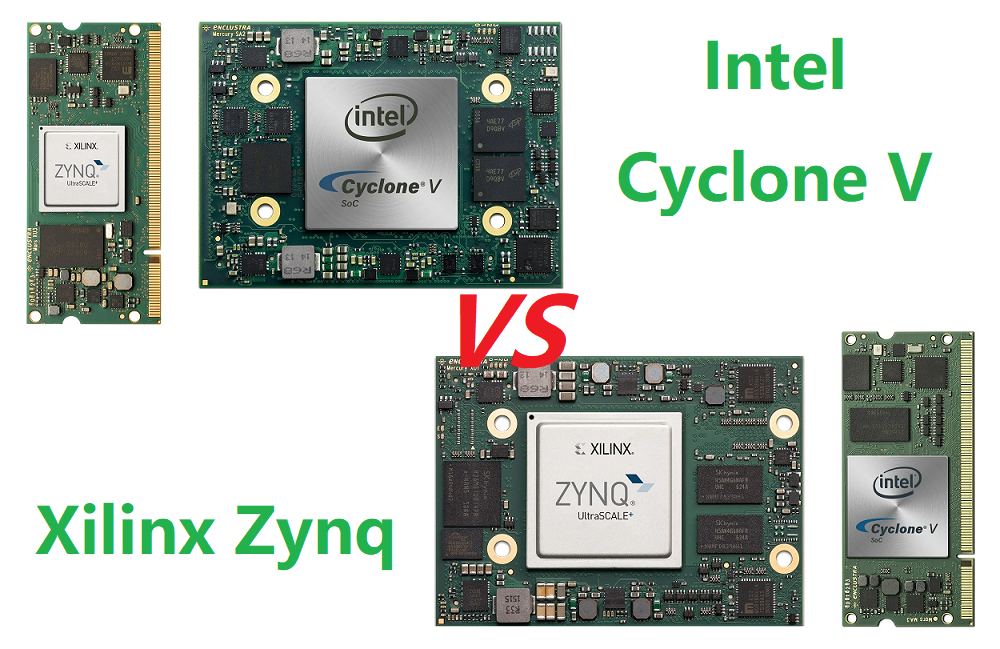Time: 2025-04-30 11:23:54View:
| Feature | Xilinx Zynq-7000 | Intel Cyclone V (SoC Variant) |
|---|---|---|
| Type | FPGA + ARM Cortex-A9 SoC | FPGA + ARM Cortex-A9 Hard Processor |
| Primary Use Cases | Embedded vision, motor control, industrial automation | Industrial IoT, edge computing, embedded control |
| Key Differentiator | Tight PS-PL integration, Linux-ready | Lower cost, simpler integration |

Zynq: Fully-coherent AXI buses between Processing System (PS) and Programmable Logic (PL)
Cyclone V: Separate HPS (Hard Processor System) with bridge connections to FPGA
| Parameter | Zynq-7020 | Cyclone V 5CSEBA6 |
|---|---|---|
| Logic Cells | 85K | 110K |
| ARM Cores | Dual-core Cortex-A9 | Single-core Cortex-A9 |
| Clock Speed | 766MHz (max) | 925MHz (max) |
| On-Chip Memory | 256KB | 64KB |
| DSP Slices | 220 | 150 |
Xilinx Zynq Advantages:
Dual-core processor standard across all models
Dedicated DMA controllers between PS-PL
Supports Linux/FreeRTOS out-of-the-box
More advanced debugging (ChipScope)
Intel Cyclone V Advantages:
~30% lower power consumption
Lower cost for equivalent logic capacity
Simpler HPS-FPGA interface
Better legacy peripheral support
| Aspect | Zynq | Cyclone V |
|---|---|---|
| Primary IDE | Vivado + Vitis | Quartus Prime + SoC EDS |
| OS Support | Full Linux/Yocto | Lightweight Linux/Altera OS |
| Debug Tools | XMD, SDK | SignalTap, System Console |
| IP Availability | More ARM-centric IP | More FPGA-focused IP |
Motor Control Application:
Zynq: 2.1μs latency PS-PL
Cyclone V: 3.8μs latency HPS-FPGA
Video Pipeline:
Zynq handles 1080p60 more efficiently
Cyclone V requires more FPGA resources for same task
| Model | Zynq-7020 | Cyclone V 5CSEMA5 |
|---|---|---|
| Unit Price | ~$85 | ~$65 |
| Dev Board | ZedBoard ($399) | DE10-Nano ($229) |
| Longevity | Until 2035 | Until 2030 |
From Zynq to Cyclone V:
Expect to rewrite PS-PL communication layers
May need to consolidate to single-core design
From Cyclone V to Zynq:
Can leverage dual-core capabilities
Easier to implement complex OS features
Choose Zynq When:
Need dual-core processing
Implementing complex embedded Linux systems
Require tight PS-PL coupling (e.g., real-time control)
Choose Cyclone V When:
Cost-sensitive projects
Single-core suffices
Prefer Intel's FPGA toolchain
Zynq Upgrade Path: Zynq UltraScale+ MPSoC
Cyclone V Successor: Cyclone 10 GX
Zynq-7020 Performance:
2.1μs total loop latency (PS→PL→Motor→Sensor→PL)
Can run Field-Oriented Control (FOC) entirely in PL
Dual-core allows:
Core 1: Communication (EtherCAT/CAN)
Core 2: Safety monitoring
Cyclone V 5CSEMA5 Performance:
3.8μs latency (HPS→FPGA→Motor→Sensor)
Typically requires:
HPS handles comms
FPGA does PWM + basic control
Single-core may bottleneck with >3 axes
| Scenario | Zynq-7020 (Active) | Cyclone V (Active) |
|---|---|---|
| Idle (Linux Running) | 1.8W | 1.2W |
| Motor Control (1 Axis) | 2.3W | 1.7W |
| Peak (All Cores + DSP) | 3.1W | 2.4W |
| Standby | 0.5W | 0.3W |
*Note: Measured at 25°C, Vcc = 1.0V*
Cyclone V uses 28nm LP process vs Zynq's 28nm HP
Practical Implications:
Zynq requires heatsink for >70% DSP utilization
Cyclone V often needs only PCB thermal relief
For a 3-Axis Motor Controller:
| Task | Zynq Hours | Cyclone V Hours |
|---|---|---|
| Basic FPGA Logic | 40 | 35 |
| Processor Firmware | 60 | 80 |
| PS/HPS Integration | 30 | 45 |
| Debugging | 25 | 40 |
| Total | 155 | 200 |
Why the Difference?
Zynq's AXI interconnect more standardized
Altera's HPS requires more bridge configuration
| Certification | Zynq-7000 Support | Cyclone V Support |
|---|---|---|
| ISO 13849 (PLd) | Full | Limited |
| IEC 61508 SIL2 | Certified | Self-Certified |
| Automotive ASIL-B | Yes | No |
Key Observation:
Zynq has lockstep ARM cores for redundancy
Cyclone V requires external monitoring ICs
Zynq Success Case:
Industrial Robotic Arm (ABB)
6-axis control in PL
Real-time Linux in PS
<5μs safety stop reaction
Uses Zynq-7045
Benefits:
Cyclone V Success Case:
HVAC Controller (Honeywell)
30% cost savings vs Zynq
Adequate for single-axis fans
10-year battery operation
Uses Cyclone V 5CSEBA4
Advantages:
When to Switch from Cyclone V to Zynq:
Adding second motor axis
Requiring functional safety
Needing Linux (vs RTOS)
When to Downgrade from Zynq to Cyclone V:
Cost reduction needed
Single-core sufficient
Extreme low-power needs
"For new designs where power budget exceeds 2W, always choose Zynq. Below 1.5W, Cyclone V dominates. Between 1.5-2W, the decision hinges on whether you need dual-core processing or certified safety features."